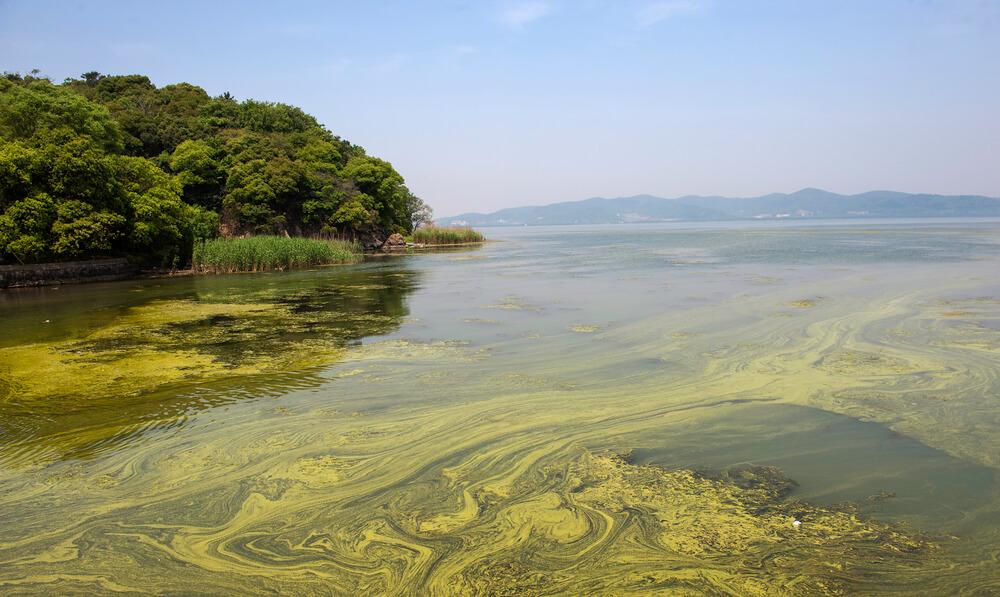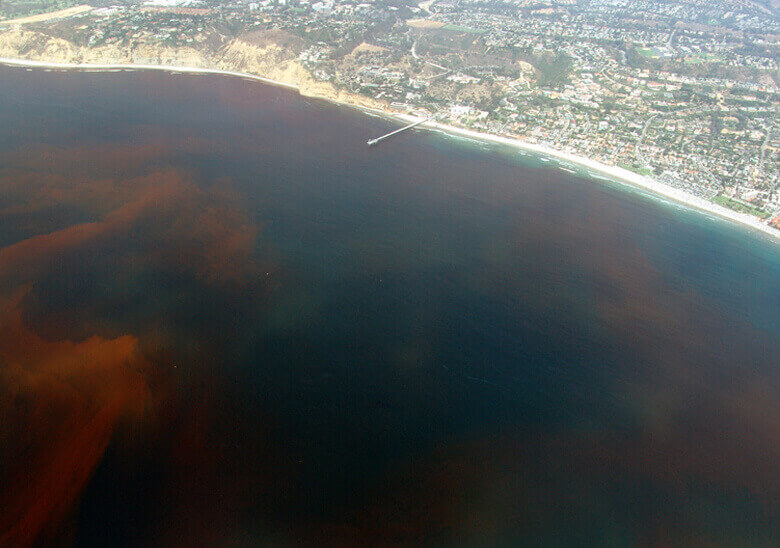Toxic algae in Florida: what you need to know and how to protect yourself
Florida is experiencing an unprecedented environmental crisis that is destroying tourism and wildlife along the southwest coast of the state.
Two species of toxic algae are blooming in the state's waters, one in fresh water and the other in salt water, creating a so-called red tide along the Gulf of Mexico and blanketing the state's rivers and canals with green vegetation, he writes. USA Today.
What you need to know about the red tide
Natural culprits of the problem
The single-celled organisms that cause red tide (karenia brevis) and blue-green blooms (cyanobacteria) are capable of photosynthesis like other plants and can move through water: karenia with their tails, cyanobacteria with gas bubbles in the water. Both types of algae are normal, natural occurrences that can be found in the water all the time, but their rapid proliferation and surge in numbers are leading to the problems Florida is facing this year.
What led to an increase in the number of algae
Freshwater blooms and red tide have been observed in the state for centuries. The problem of 2018 is not their presence in the water, but their quantity, the high intensity of the bloom, and also the fact that the bloom of salt and fresh water bodies occurs simultaneously. Typically, blue-green algae is a summer phenomenon, while red tide occurs in the winter. But this red tide began in October 2017 and is still ongoing, with no signs of stopping anytime soon.
States of emergency
Each of the blooms led to a separate statement by the Governor of Florida, Rick Scott, about the state of emergency in some districts. In July, he introduced a state of emergency in order to increase opposition to the blooming of blue-green algae, temporarily reducing the flow of polluted water from Okikoby Lake along the St. Lucie River on the east coast of the state. The governor also increased the number of state employees responsible for water testing and flowering monitoring and provided grants for heavily affected enterprises.
In August, a state of emergency decree focused on a red tide, the governor allocated 1,5 a million dollars and additional personnel to clean up the bodies of the dead marine inhabitants and save wildlife; 500 000 dollars went to a state travel agency to help them get tourists back.
Wildlife Loss
Animals die in the hundreds. The bodies of at least 700 endangered sea turtles were carried by the tide to the beaches of the state. Many of them were adults. Usually about 30-35 sea turtles perish per year. The red tide is also believed to be the cause of the death of the 8-meter whale shark, hundreds of manatees, dolphins, bass and sea birds. Scientists estimate that this bloom has influenced some populations of marine animals, which will be felt for years, and some populations may never be able to recover.
Impact on tourism and economy
In recent weeks, beaches in the southwest of Florida have been mostly empty, and businessmen, hotel owners, and landlords who are involved in tourism report losses and lower than usual occupancy rates. In a region where tourism annually brings in around 4,5 billion dollars, the slowdown is worrying, especially because it may last for the coming winter season.
Is it safe to swim in infected waters or breathe near them?
Swimming in water contaminated with blue-green algae is very dangerous; doctors advise not to do this under any circumstances. Do not allow pets near the water - they can die simply from licking a paw immersed in contaminated water. Some of the toxins produced by the cyanobacteria currently blooming in Florida are the deadliest on the planet, comparable to cobra venom or ricin.
Emissions of steam from toxic algae, which may extend up to a mile (1,6 km) from the reservoir, are also dangerous. They can cause breathing problems or nervous disorders.
In water with a red tide, swimming is relatively safe for people, it will not cause serious disorders, but can cause a burning sensation in the throat and eyes and itching of the skin. However, for domestic animals and fish red tide can be deadly. If there is a dead fish in the water, then people are not advised to swim there, because the bacteria from its decomposition can be dangerous to health.
Short term health problems
The impact of red tide on people's health is not dangerous, but it brings unpleasant symptoms: coughing, sneezing, itchy eyes and shortness of breath. Blue-green algae, however, do not always declare themselves with irritation. In places where it is concentrated, the affected person may experience breathing problems and skin rashes. The Florida Poison Control Center received 277 calls this year due to a red tide, compared to 88 last year. This year, the total number of calls for blue-green algae was 37, compared with 8 last year.
Long term impact
What happens after years or decades of exposure to red tides and toxins of blue-green algae is still being studied, but what has already been established is alarming. Studies have shown the relationship of cyanotoxins with liver disease, Alzheimer's disease, Parkinson's disease and Lou Gehrig's disease. But since these problems usually manifest themselves years after contact with bacteria, it is rather difficult to track down and accurately establish their relationship.

Фото: Depositphotos
Are Florida Seafood Safe?
It is quite difficult to give an unequivocal answer to this question, but for most consumers who buy Florida seafood in other states, their use is most likely safe.
First, most fish and shrimp are caught far away on the shelf, where there is no red tide. Even if seafood was obtained in the affected areas, toxins accumulate in the guts, and it is these parts that are removed before being sold. The State Commission for the Conservation of Wildlife and Fishing claims that eating seafood from Florida does not pose a risk to human health.
However, the agency's statement clarifies: "It is never recommended to eat dead or weakened marine animals, especially in red tide areas." Blue-green algae is another problem. Although some studies show high concentrations of toxins in freshwater fish, and one toxin—BMAA—can reach particularly high levels in blue crabs, the state Department of Health says it is safe to eat seafood from waters contaminated with blue-green algae.
Work with consequences
Cleaning the effects of algae blooms is a very difficult task. In the past two weeks, almost 150 000 gallons (568 thousand liters) of algae slurry were cleaned in the Lee district in a cleanup program.
In August, workers collected more than 1400 tons of dead fish in Lee County.
When will it end
This is a question that even scientists have no answer to, especially since the current red tide has spread far beyond the normal timeframe for its activation. Scientists are trying to understand what caused this anomalous aggravation and do not undertake to predict when the flowering will end.
Read also on ForumDaily:
Dozens of lakes in New York are contaminated with toxic algae
Toxic algae in Florida kill thousands of fish every day and make people sick
Florida Governor has introduced a state of emergency in seven districts
Subscribe to ForumDaily on Google NewsDo you want more important and interesting news about life in the USA and immigration to America? — support us donate! Also subscribe to our page Facebook. Select the “Priority in display” option and read us first. Also, don't forget to subscribe to our РєР ° РЅР ° Р »РІ Telegram and Instagram- there is a lot of interesting things there. And join thousands of readers ForumDaily New York — there you will find a lot of interesting and positive information about life in the metropolis.
-
Personal experience: who and why you should not move to the USA5614
-
50 diseases whose presence will increase the cost of health insurance in the USA4329
-
Great opportunities with ChatGPT: 12 easy ways to make money using artificial intelligence1324
-
What should not be on your resume if you want to find a job in the USA763
-
Four unforgivable mistakes immigrants make to the United States552
-
Dependence on cars and one supermarket per city: why ours is unusual in one-story America403
-
Ten secret restaurants in the USA: what is their highlight and how to find them254
-
Personal experience: who and why you should not move to the USA5614
-
Where in the USA to buy the medicines we are used to: a list of pharmacies5330
-
How to hit the jackpot: tips from a man who won the lottery 7 times4898
-
50 diseases whose presence will increase the cost of health insurance in the USA4329
-
Street, avenue, boulevard or drive: how to understand the classification of US streets and roads1461
-
Personal experience: what not to do in America1402
-
Great opportunities with ChatGPT: 12 easy ways to make money using artificial intelligence1324












